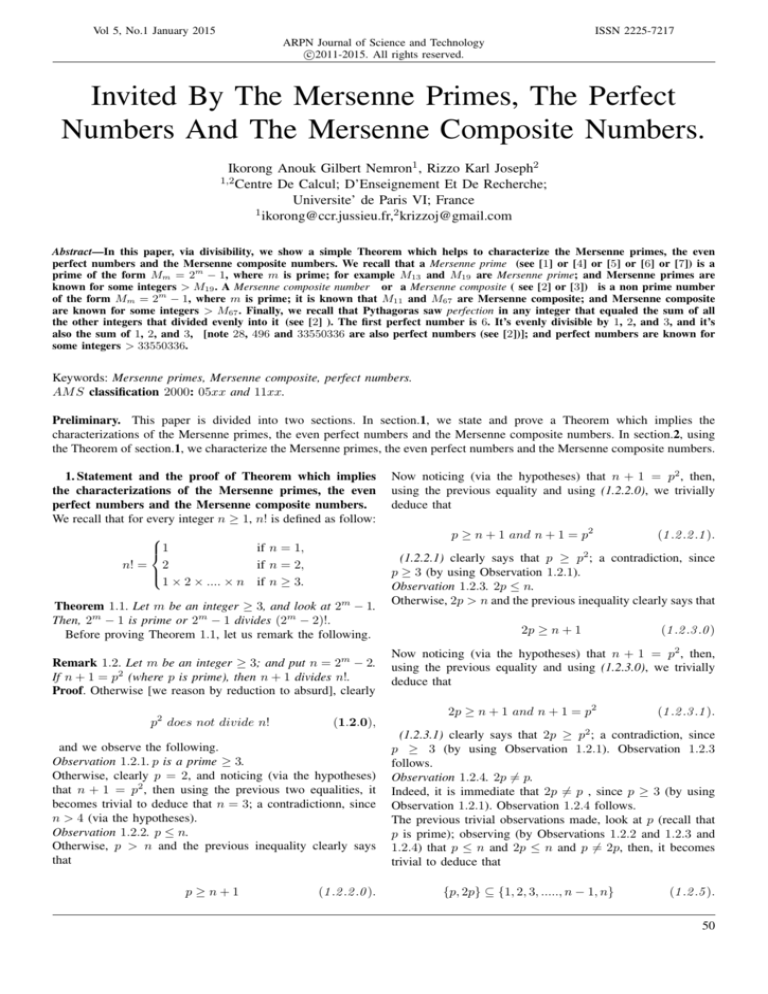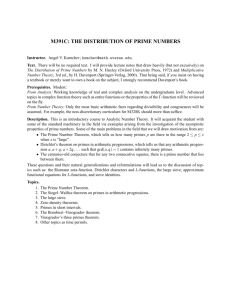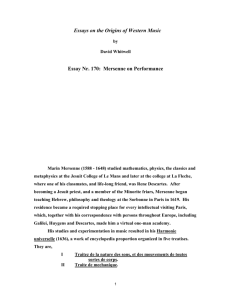
Vol 5, No.1 January 2015
ISSN 2225-7217
ARPN Journal of Science and Technology
c
2011-2015.
All rights reserved.
Invited By The Mersenne Primes, The Perfect
Numbers And The Mersenne Composite Numbers.
Ikorong Anouk Gilbert Nemron1 , Rizzo Karl Joseph2
De Calcul; D’Enseignement Et De Recherche;
Universite’ de Paris VI; France
1 ikorong@ccr.jussieu.fr,2 krizzoj@gmail.com
1,2 Centre
Abstract—In this paper, via divisibility, we show a simple Theorem which helps to characterize the Mersenne primes, the even
perfect numbers and the Mersenne composite numbers. We recall that a Mersenne prime (see [1] or [4] or [5] or [6] or [7]) is a
prime of the form Mm = 2m − 1, where m is prime; for example M13 and M19 are Mersenne prime; and Mersenne primes are
known for some integers > M19 . A Mersenne composite number or a Mersenne composite ( see [2] or [3]) is a non prime number
of the form Mm = 2m − 1, where m is prime; it is known that M11 and M67 are Mersenne composite; and Mersenne composite
are known for some integers > M67 . Finally, we recall that Pythagoras saw perfection in any integer that equaled the sum of all
the other integers that divided evenly into it (see [2] ). The first perfect number is 6. It’s evenly divisible by 1, 2, and 3, and it’s
also the sum of 1, 2, and 3, [note 28, 496 and 33550336 are also perfect numbers (see [2])]; and perfect numbers are known for
some integers > 33550336.
Keywords: Mersenne primes, Mersenne composite, perfect numbers.
AM S classification 2000: 05xx and 11xx.
Preliminary. This paper is divided into two sections. In section.1, we state and prove a Theorem which implies the
characterizations of the Mersenne primes, the even perfect numbers and the Mersenne composite numbers. In section.2, using
the Theorem of section.1, we characterize the Mersenne primes, the even perfect numbers and the Mersenne composite numbers.
1. Statement and the proof of Theorem which implies
the characterizations of the Mersenne primes, the even
perfect numbers and the Mersenne composite numbers.
We recall that for every integer n ≥ 1, n! is defined as follow:
1
n! = 2
1 × 2 × .... × n
p ≥ n + 1 and n + 1 = p2
if n = 1,
if n = 2,
if n ≥ 3.
Theorem 1.1. Let m be an integer ≥ 3, and look at 2m − 1.
Then, 2m − 1 is prime or 2m − 1 divides (2m − 2)!.
Before proving Theorem 1.1, let us remark the following.
Remark 1.2. Let m be an integer ≥ 3; and put n = 2m − 2.
If n + 1 = p2 (where p is prime), then n + 1 divides n!.
Proof. Otherwise [we reason by reduction to absurd], clearly
p2 does not divide n!
(1 .2 .2 .1 ).
(1.2.2.1) clearly says that p ≥ p2 ; a contradiction, since
p ≥ 3 (by using Observation 1.2.1).
Observation 1.2.3. 2p ≤ n.
Otherwise, 2p > n and the previous inequality clearly says that
2p ≥ n + 1
(1 .2 .3 .0 )
Now noticing (via the hypotheses) that n + 1 = p2 , then,
using the previous equality and using (1.2.3.0), we trivially
deduce that
2p ≥ n + 1 and n + 1 = p2
(1 .2 .3 .1 ).
(1.2.0),
and we observe the following.
Observation 1.2.1. p is a prime ≥ 3.
Otherwise, clearly p = 2, and noticing (via the hypotheses)
that n + 1 = p2 , then using the previous two equalities, it
becomes trivial to deduce that n = 3; a contradictionn, since
n > 4 (via the hypotheses).
Observation 1.2.2. p ≤ n.
Otherwise, p > n and the previous inequality clearly says
that
p≥n+1
Now noticing (via the hypotheses) that n + 1 = p2 , then,
using the previous equality and using (1.2.2.0), we trivially
deduce that
(1 .2 .2 .0 ).
(1.2.3.1) clearly says that 2p ≥ p2 ; a contradiction, since
p ≥ 3 (by using Observation 1.2.1). Observation 1.2.3
follows.
Observation 1.2.4. 2p 6= p.
Indeed, it is immediate that 2p 6= p , since p ≥ 3 (by using
Observation 1.2.1). Observation 1.2.4 follows.
The previous trivial observations made, look at p (recall that
p is prime); observing (by Observations 1.2.2 and 1.2.3 and
1.2.4) that p ≤ n and 2p ≤ n and p 6= 2p, then, it becomes
trivial to deduce that
{p, 2p} ⊆ {1, 2, 3, ....., n − 1, n}
(1 .2 .5 ).
50
Vol 5, No.1 January 2015
ISSN 2225-7217
ARPN Journal of Science and Technology
c
2011-2015.
All rights reserved.
(1.2.5) immediately implies that
p × 2p divides 1 × 2 × 3 × ... × n − 1 × n
(1 .2 .6 ).
(1.2.6) clearly says that 2p2 divides n!; in particular p2 clearly
divides n! and this contradicts (1.2.0). Remark 1.2 follows. 2
The previous remark made, now we prove Theorem 1.1.
Proof of Theorem 1.1. Put n = 2m − 2 and look at
n + 1. If n + 1 is prime, then the proof is ended. If n + 1 is
not prime, then n + 1 divides n!. Otherwise (we reason by
reduction to absurd)
n + 1 is not prime and n + 1 does not divide n! (1.1.0),
and we observe the following.
Observation 1.1.1. Let p be a prime such that n + 1 is
is an
divisible by p ( such a p clearly exists). Then n+1
p
n+1
integer and n+1
≤
n
and
p
≤
n
and
=
p.
p
p
Indeed, it is immediate that n+1
is
an
integer
[since p divides
p
n + 1], and it is also immediate that n+1
≤
n [otherwise,
p
n + 1 > np; now, remarking that p ≥ 2 (since p is prime),
then the previous two inequalities imply that n + 1 > 2n;
so 1 > n and we have a contradiction, since n > 4, by the
hypotheses]. Clearly p ≤ n [otherwise, p > n; now, recalling
that n + 1 is divisible by p, then the previous inequality
implies that n + 1 = p. Recalling that p is prime, then the
previous equality clearly says that n + 1 is prime and this
contradicts (1.1.0)]. That being so, to prove Observation
1.1.1, it suffices to prove that n+1
= p. Fact: n+1
= p
p
p
n+1
[otherwise, clearly p 6= p; now, remarking (by using the
previous) that n+1
is an integer and n+1
≤ n and p ≤ n;
p
p
then it becomes trivial to deduce that n+1
and p are two
p
different integers such that {p, n+1
}
⊆
{1,
2,
3,
....., n − 1, n}.
p
The previous inclusion immediately implies that p × n+1
p
divides 1 × 2 × 3 × ... × n − 1 × n; therefore n + 1 divides n!,
and this contradicts (1.1.0). So n+1
p = p]. Observation 1.1.1
follows.
The previous trivial observation made, look at n + 1;
observing (by using Observation 1.1.1) that p is prime such
that n+1
p = p, clearly
n + 1 = p2 , where p is prime
(1 .1 .2 ).
Now using (1.1.2) and Remark 1.2, then it becomes trivial
to deduce that n + 1 divides n!, and this contradicts (1.1.0).
Theorem 1.1 follows. 2
Theorem 1.1 immediately implies the characterizations of
Mersenne primes, even perfect numbers and Mersenne
composite numbers.
2. Characterizations of Mersenne primes, even perfect
numbers and Mersenne composite numbers.
In this section, using Theorem 1.1, we characterize Mersenne
primes, even perfect numbers and Mersenne composite
numbers.
Theorem 2.1. (Characterization of Mersenne primes).
Let m be an integer ≥ 3 and look at 2m − 1. Then the
following are equivalent.
(1). 2m − 1 is a Mersenne prime.
(2). 2m − 1 does not divide (2m − 2)!.
To prove Theorem 2.1, we need a Theorem of Euclide.
Theorem 2.2 (Euclide). Let a, b and c, be integers
such that a ≥ 1, b ≥ 1 and c ≥ 1. If a divides bc and if
the greatest common divisor of a and b is 1, then a divides c.2
Corollary 2.3. Let n be an integer ≥ 1 and look at
n!. Now let p be a prime ≥ n + 1; then the greatest common
divisor of n! and p is 1 (in particular, p does not divide n!).
Proof. Immediate, and follows immediately by using Theorem
2.2 and the definition of n!, and by observing that p is a
prime ≥ n + 1.2
Now, we simply prove Theorem 2.1.
Proof of Theorem 2.1. (1) ⇒ (2)]. Immediate, by
puting n = 2m − 2 and by remarking that n + 1 is prime and
by using Corollary 2.3.
(2) ⇒ (1)]. Immediate. Indeed, since 2m − 1 does not divide
(2m − 2)!, then, using Theorem 1.1, we immediately deduce
that
2m − 1 is prime
(2 .1 .0 ).
m
That being so, since 2 − 1 is prime (by (2.1.0)), then it
becomes immediate to deduce that
m is prime
(2 .1 .1 ).
Consequently 2m − 1 is a Mersenne prime (by using (2.1.0)
and (2.1.1) ). 2
Using Theorem 2.1, then the following two Theorems
become immediate.
Theorem 2.4. (Characterization of even perfect numbers).
Let m be an integer ≥ 3 and look at 2m − 1. Then the
following are equivalent.
(1). 2m−1 (2m − 1) is an even perfect number.
(2). 2m − 1 does not divide (2m − 2)!.
To prove Theorem 2.4, we need the following known Theorem
Theorem 2.5. (Euler). The following are equivalent.
(1). e is an even perfect number.
(2). e is of the form 2m−1 (2m − 1), where 2m − 1 is prime.
2
Proof of Theorem 2.4. Immediate and follows by using
Theorem 2.5 and Theorem 2.1. 2
Theorem 2.6. (Characterization of Mersenne composite
numbers). Let m be a prime ≥ 3 and look at 2m − 1. Then
the following are equivalent.
(1). 2m − 1 is a Mersenne composite number.
(2). 2m − 1 divides (2m − 2)!.
Proof. Immediate, by observing that m is a prime ≥ 3 and
by using Theorem 2.1. 2
51
Vol 5, No.1 January 2015
ISSN 2225-7217
ARPN Journal of Science and Technology
c
2011-2015.
All rights reserved.
References.
[1] Ikorong Anouk Gilbert Nemron. An original symposium over the Goldbach
conjecture, The Fermat primes, The Fermat composite numbers conjecture, and the
Mersenne primes conjecture .Mathematicae Notae. Vol XLV (2008). 31 − 39.
[2] Ikorong Anouk Gilbert Nemron. An original abstract over the twin primes,
the Goldbach Conjecture, the Friendly numbers, the perfect numbers, the Mersenne
composite numbers, and the Sophie Germain primes. Journal of Discrete Mathematical
Sciences And Cryptography; Taru Plublications; Vol.11; Number.6, (2008). 715 − 726.
[3] Ikorong Anouk Gilbert Nemron. A Glance At A Different Kinds Of Numbers.
International Journal Of Mathematics And Computer Sciences. Vol.4, No.1, 2009.
43 − 53.
[4] Ikorong Anouk Gilbert Nemron. Runing With The Twin Primes, The Goldbach
Conjecture, The Fermat Primes Numbers, The Fermat Composite Numbers, And The
Mersenne Primes; Far East Journal Of Mathematical Sciences; Volume 40, Issue 2,
M ay2010, 253 − 266.
[5] Ikorong Anouk Gilbert Nemron. Speech around the twin primes conjecture, the
Mersenne primes conjecture, and the Sophie Germain primes conjecture; Journal Of
Informatics And Mathematical Sciences; Volume 3, 2011, No 1, 31 − 40.
[6] Paul Hoffman. Erdös, l’homme qui n’aimait que les nombres. Editions Belin,
(2000). 30 − 49.
[7] Paul Hoffman. The man who loved only numbers. The story of Paul Erdös and the
search for mathematical truth. 1998. 30 − 49.
52










